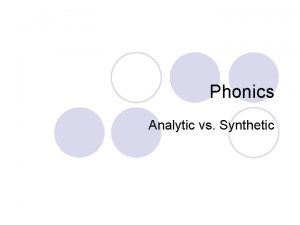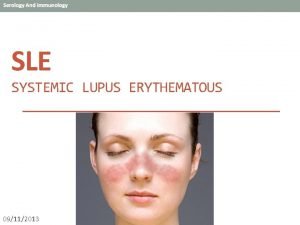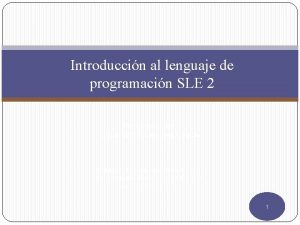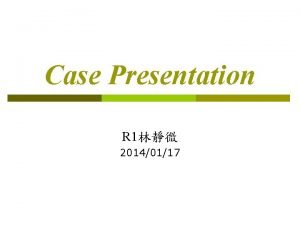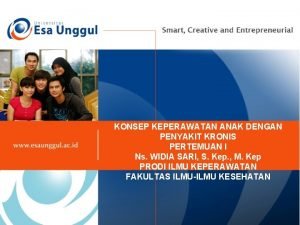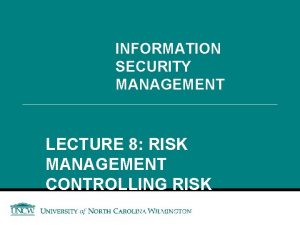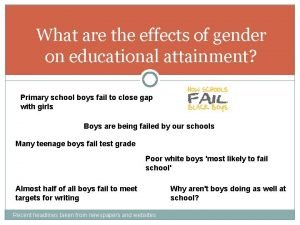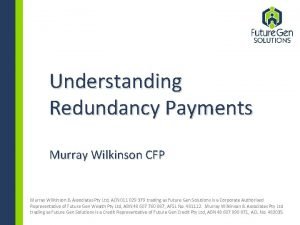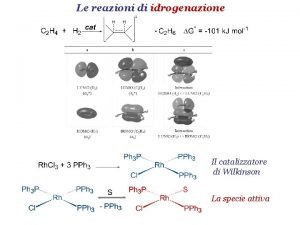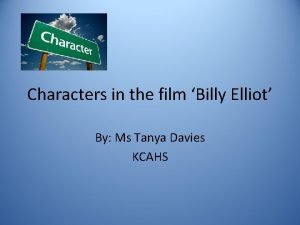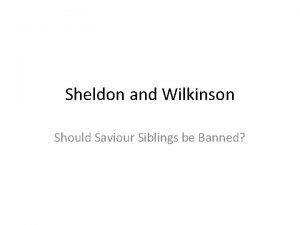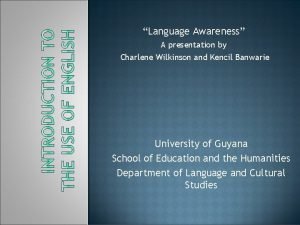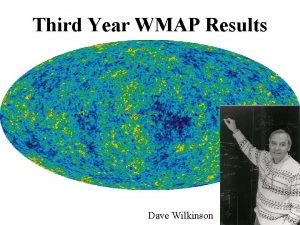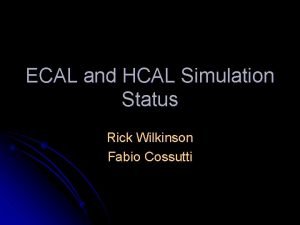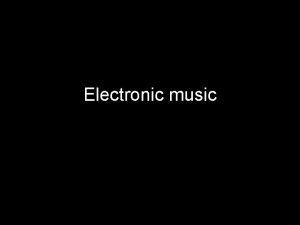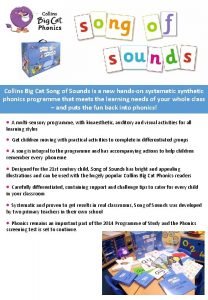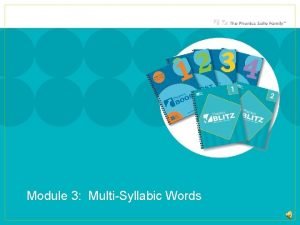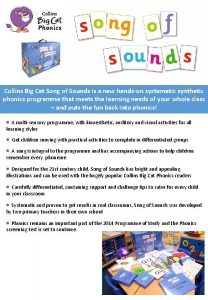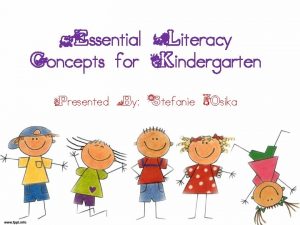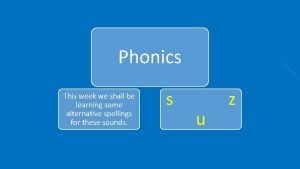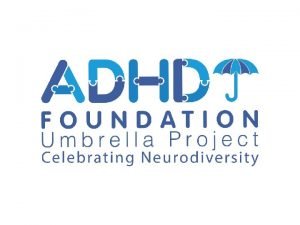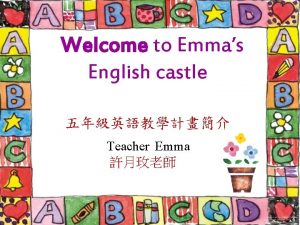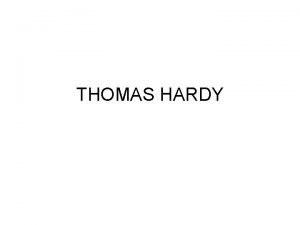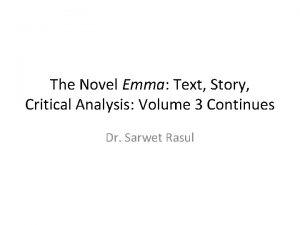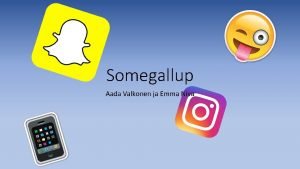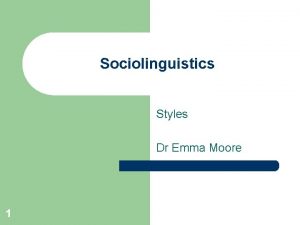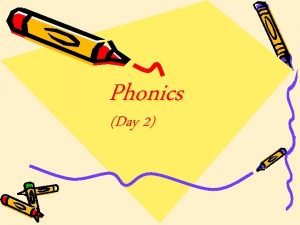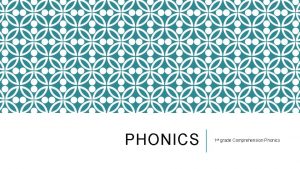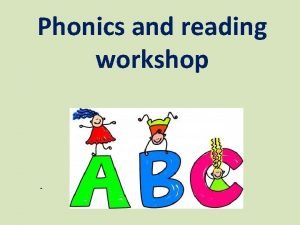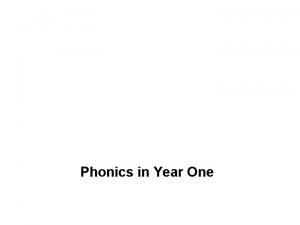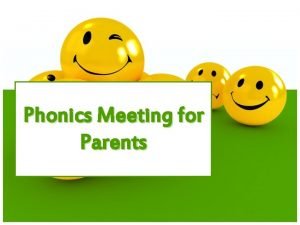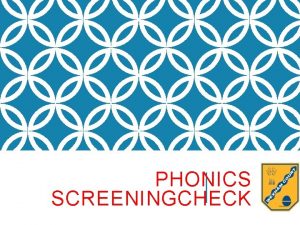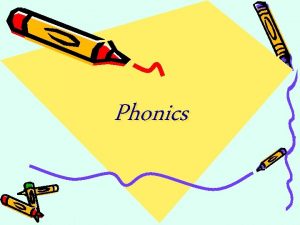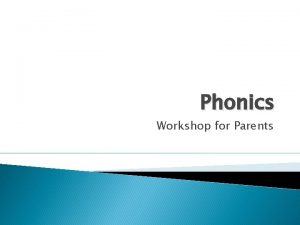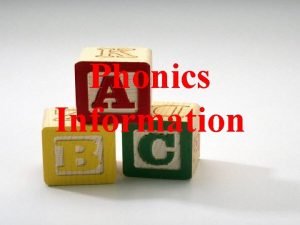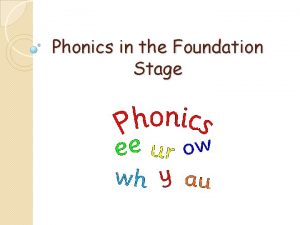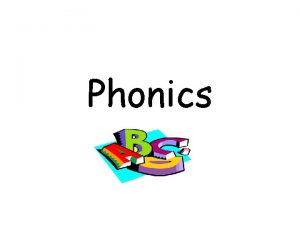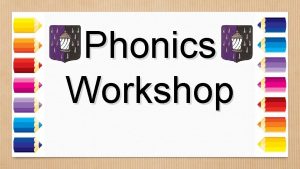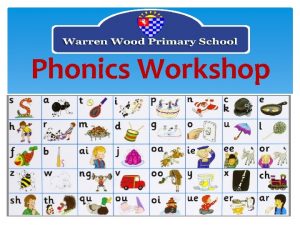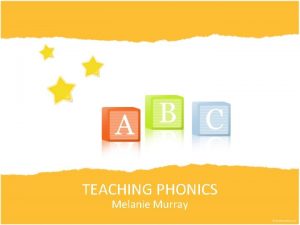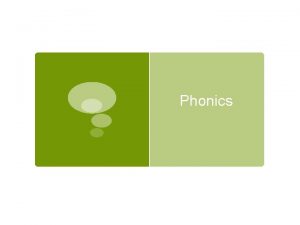Phonics Emma Wilkinson Phonics SLE Phonics and Music


















































- Slides: 50

Phonics

Emma Wilkinson Phonics SLE Phonics and Music Subject Leader EYFS Teacher Wensley Fold CE Primary Academy

Phonics Training What is Phonics? To develop phonic subject knowledge. To look at the structure of a Phonics session.

Listen up! Phonics ain’t easy I take it you already know Of tough and cough and dough? Others may stumble but not you, On thorough, laugh and through. Well done! And now you wish, perhaps, to learn of less familiar traps?

Beware of heard, a dreadful word That looks like beard and sounds like bird, And dead: it’s said like bed, not bead – For goodness sake don’t call it ‘deed’! Watch out for meat and great and threat (They rhyme with suite and straight and debt).

A moth is not a moth when it is in mother Nor both in bother, broth and brother, And here is not a match for there Nor dear and fear for bear and pear, Just look them up – and goose and choose, And cork and work and card and ward, And font and front and word and sword, And do and go, and thwart and cart – Come, come, I’ve hardly made a start! A dreadful language? Man alive. I mastered it when I was five.

• How did you learn to read? • What’s your knowledge of phonics? • What are your concerns about teaching phonics?

Why teach phonics?

Pre teaching vocabulary strategies Narrative frameworks and strategies

“Synthetic phonics offers the vast majority of young children the best and most direct route to becoming skilled readers and writers” Sir Jim Rose Review of Reading 2006

What is Phonics? phonics is skills of segmentation and blending + knowledge of the alphabetic code

Terminology Phoneme = smallest unit of sound in a word c-a-t d-o-g sh-ee-p

Enunciation • Teaching phonics requires a technical skill in enunciation. • Phonemes should be articulated clearly and precisely.


Teaching Sounds

Read Write Inc

s d u ll z ai ur a t p g o c r h b ss j v zz qu ch ee igh oa ow oi ear i n m k ck e f ff l w x y sh th ng oo ar or air ure er

• Grapheme = a letter or sequence of letters that represents a phoneme t ai igh

Digraph – two letters that make one sound ch ck th ng Vowel Digraph - contains at least one vowel ai ee ar oy Split digraph - digraph in which the two letters are not adjacent make flute

Adjacent consonants– two or more consonants next to each other in a word – stop list – CAN PROVE TRICKY Beware – Adjacent consonants are not digraphs. They make two distinct sounds. Not ‘blends’ like they used to be e. g. bl, fr … Trigraph – three letters that make one sound air ear igh

How many phonemes can you hear?

Segmenting Activity WORD shelf dress think string sprint flick

Segmenting WORD shelf sh e l f dress d r e ss think th i n k string s t r i ng sprint s p r i n flick f l i ck t

• Sounds/phonemes are represented by letters • A phoneme can be represented by one or more letters e. g. sh, th, ee, etc • The same phoneme can be represented/ spelled in more than one way e. g. rain, may, lake • The same spelling may represent more than one sound e. g. mean, deaf

The same phoneme can be represented in more than one way: burn first term heard work

CHALLENGE! ur ir er ear or

6 Phonic phases • Phase 1 in Nursery • Phase 2 and 3 in Reception (Phase 3 split into 3 i, 3 ii & 3 iii) • Phase 4 and 5 in Year 1 (Phase 5 split into 5 a, 5 b, & 5 c) • Phase 6 in Year 2 • Carried on into KS 2

Letters and Sounds Phase 1 Ready For Sounds assessment Phase 2 Up to 6 Weeks Phase 3 Up to 12 Weeks Phase 4 Up to 6 Weeks Phase 5 Throughout Year 1 Phase 6 Throughout Year 2

Robot Talk

Phonics v system of linking individual speech sounds – phonemes with graphemes SO learner needs to be primed by being sensitive to the phonological structure of spoken words

Purpose of phase 1 • Explore and experiment with sounds and words • Distinguish between different sounds in the environment and phonemes • Learn to orally blend and segment sounds in words

By the end of phase 1 • Children will have experienced a wealth of listening activities including songs, stories and rhymes. • They will be able to distinguish between speech sounds and many will be able to blend and segment words orally. • Some will also be able to recognise spoken words that rhyme and will be able to provide a string of rhyming words, but inability to do this does not prevent moving on to Phase Two as these speaking and listening activities continue.

Games for Phase 1 • Phase 1 activities are primarily pitched at 3 to 5 year olds. The learning in the recommended games is suitable for Key Stage two children with language and learning difficulties but all activities would need to be made age appropriate.


Development of rhyme • 3 year olds are aware of rhyme • Children treat nonsense words the same as real words i. e. they will generate strings of rhyming words of which may be nonsense words. • does ‘chair’ or ‘flag’ rhyme with ‘pair’ • 4 -5 year 77% success • 5 – 6 year 83% success • 6 -7 year 87% success


Identification of syllables • Syllable tapping • 5 year 46% success • 6 years 48% success • 7 years 90% success

How many claps?

Rhyming pairs and strings Children need to ‘tune into’ the language they hear and for some children rhyme is very difficult – possibly due to poor working memory and/or processing difficulties, not given enough time to consolidate and practice this particular skill. Try these (all oral – nothing written yet!): Generate rhyming words, including nonsense words – make up ‘silly rhymes’ Pairs using rhyming lists Snap games Odd-one-out i. e. ‘cat / bat / pot’


Purpose of phase 2 up to 6 weeks l Learn 19 phonemes and know the graphemes that represent them. l Move on from orally blending and segmenting to blending and segmenting letters to read and spell (maybe with magnetic letters) VC and CVC words l Introduce two syllable words, simple captions and some tricky HFW.

Phase 2 letter progression Set 1: Set 2: Set 3: Set 4: Set 5: s I g ck h a n o e b t m c u f, ff p d k r l, ll ss

CVC Words • C consonant phoneme • V vowel phoneme • C consonant phoneme

Are these CVC words? ship hill sing Why are these words not CVC words? saw her few

CVC words – clarifying some misunderstandings pig ship boy fill song day whizz thick car cow whip for miss huff Which are CVC words?

pig th i c k ship car X boy X cow. X fill whip song for X day X whizz miss huff

Teaching sequence • Revisit and review • Teach • Practice • Apply

Teaching sequence • Revisit and review • Practise previously learned phonemes and graphemes • Practice oral blending and segmenting • Teach • • • Teach a new grapheme/phoneme Teach blending and/or segmentation of phonemes in words Teach one or two tricky words Practice Practise reading and/or spelling with the new phoneme/grapheme • Apply • Make frequent links between the phonics sessions and reading and writing throughout the day and across the curriculum. Give children lots of opportunities, right from the start of the programme, to use their phonics knowledge for reading and writing. • It’s what they’re for!

Applying l l l l Must have opportunities in class to read and write the words that they have been learning in phonics sessions. Guided reading Shared reading Captions Labels Whiteboards and pens Magnetic letters Differentiated literacy work

For next time Observe a series Phonics sessions.
 Music music music
Music music music Analytic phonics
Analytic phonics Drug induced sle
Drug induced sle Sle service level expectation
Sle service level expectation Asuhan keperawatan sle
Asuhan keperawatan sle Anemia sle
Anemia sle Transvers miyelit
Transvers miyelit Anemia sle
Anemia sle Nvle fonds
Nvle fonds Dr jakab lászló immunológus
Dr jakab lászló immunológus Sle programación
Sle programación Takayasu arteritis
Takayasu arteritis Sle vasculitis
Sle vasculitis Dopamine rash sle
Dopamine rash sle Front immunology
Front immunology Subchondrial
Subchondrial Konsep keperawatan anak dengan penyakit kronis
Konsep keperawatan anak dengan penyakit kronis Sle aro ale examples
Sle aro ale examples Wilkinson genderquake sociology
Wilkinson genderquake sociology Murray wilkinson
Murray wilkinson Catalizzatore di wilkinson
Catalizzatore di wilkinson Divisor de potencia wilkinson
Divisor de potencia wilkinson Billy elliot character description
Billy elliot character description Wilkinson polynomial
Wilkinson polynomial Adc
Adc Esther wilkinson
Esther wilkinson Daryl wilkinson
Daryl wilkinson Wilkinson adc converter
Wilkinson adc converter Saviour baby
Saviour baby Wilkinson exo
Wilkinson exo Charlene wilkinson
Charlene wilkinson Schmenitration
Schmenitration Dave wilkinson model
Dave wilkinson model Fabio wilkinson
Fabio wilkinson Romantic time period
Romantic time period Rhythm music appreciation
Rhythm music appreciation Music that employs electronic music
Music that employs electronic music Region 1 musical instruments
Region 1 musical instruments Big cat song
Big cat song Phonics blitz online
Phonics blitz online Big cat song
Big cat song Fountas and pinnell phonics kindergarten
Fountas and pinnell phonics kindergarten Phonics play obb and bob
Phonics play obb and bob Emma watson adhd
Emma watson adhd Emma english teacher
Emma english teacher Emma gifford
Emma gifford Emma gifford
Emma gifford Emma critical analysis
Emma critical analysis Emma antunes nasa
Emma antunes nasa Emma niva
Emma niva Dr emma moore
Dr emma moore

